Key takeaways:
- Embrace adaptability in budgeting; methods should evolve with life changes and personal circumstances.
- Set realistic financial goals by breaking down ambitions into achievable milestones and regularly tracking progress.
- Maintain your budget through automation, visual representation, and accountability with a trusted friend to enhance commitment.
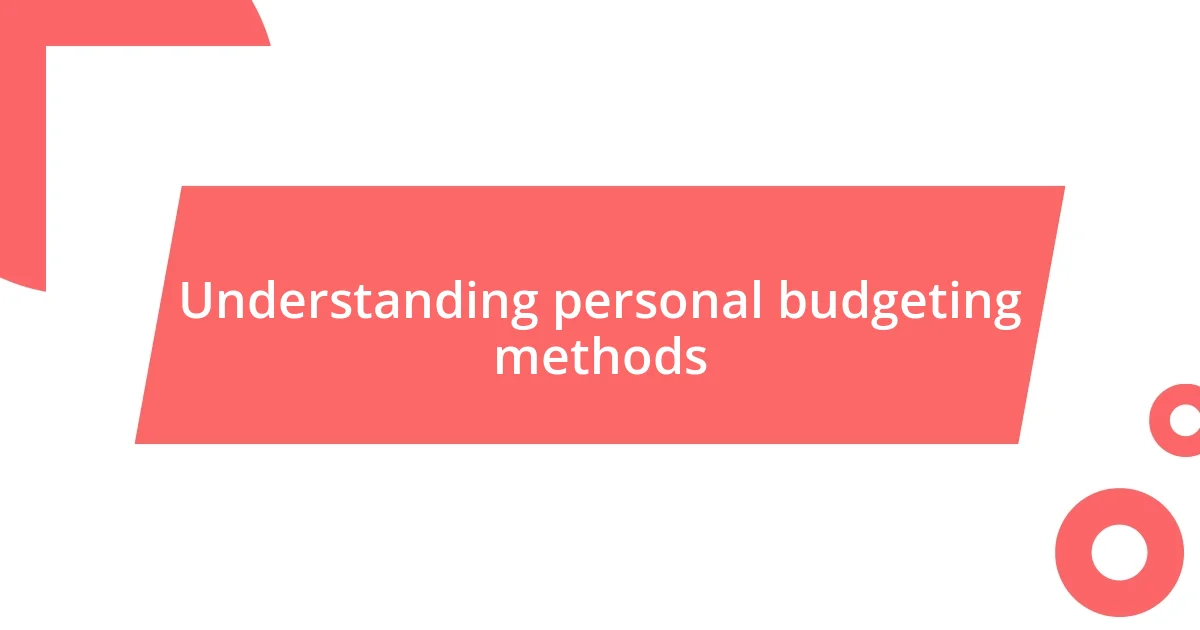
Understanding personal budgeting methods
When I first delved into personal budgeting methods, I quickly discovered that there isn’t a one-size-fits-all approach. I remember feeling overwhelmed by the variety of options—envelope systems, zero-based budgeting, and even the 50/30/20 rule all seemed viable. But I had to ask myself: which method actually resonates with my lifestyle and spending habits?
One method that clicked for me was the zero-based budgeting approach. It was liberating to allocate every dollar I earned to specific categories, down to zero by the end of the month. This method made me more mindful, forcing me to confront expenses that I previously ignored—like my spontaneous coffee runs. Have you ever noticed how those small splurges can really add up over time?
As I experimented with different methods, I realized the importance of being adaptable. For instance, when my work situation changed unexpectedly, I had to rethink how I approached budgeting. This fluidity is crucial; life changes require adjustments in our financial plans. It’s a comforting thought that budgeting can evolve alongside us, making it feel less like a chore and more like a dynamic tool for achieving my goals.
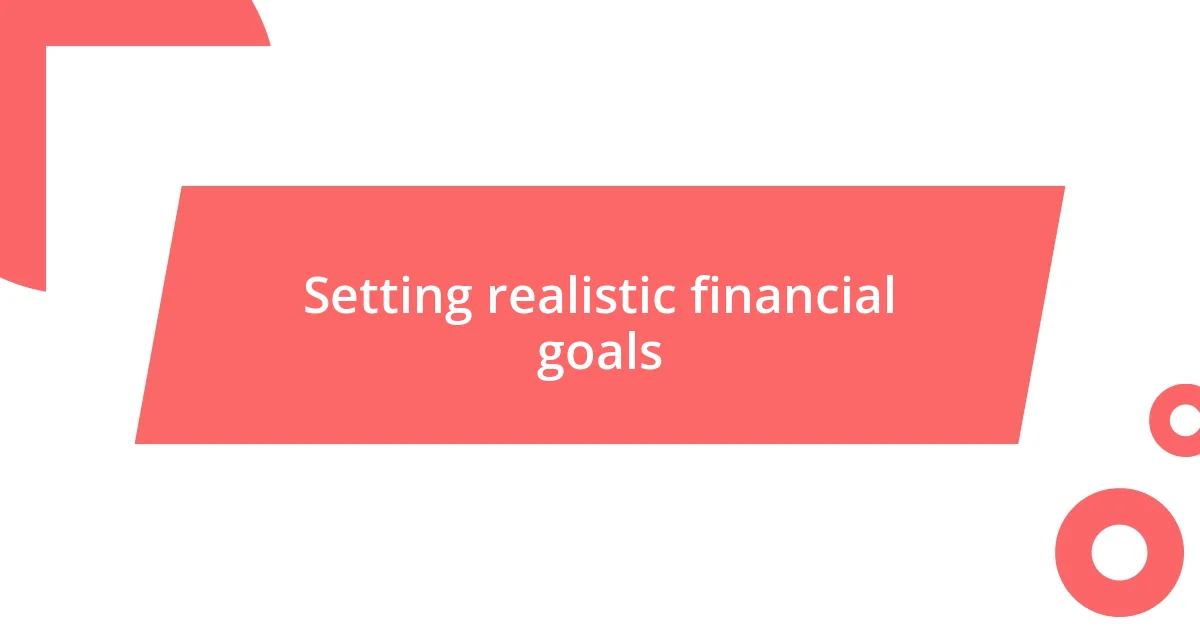
Setting realistic financial goals
Setting realistic financial goals has been a game changer for me. I remember setting an ambitious goal to save a hefty amount each month without really considering my current expenses and lifestyle. I quickly became discouraged when I fell short. That’s when I learned the importance of breaking down those lofty aspirations into more achievable milestones. For instance, instead of aiming to save $500 a month right off the bat, I focused on saving just $100. This not only felt attainable but also built my confidence and kept me motivated.
Here are some tips that have worked well for me in setting realistic financial goals:
- Assess Your Current Financial Situation: Take a close look at your income and expenses. Understanding where you stand financially is the first step in goal-setting.
- Prioritize Your Goals: Decide what’s most important to you—saving for a trip, building an emergency fund, or paying off debt. This helps in focusing your efforts effectively.
- Set Specific Timeframes: Give yourself a clear deadline for each goal. This helps maintain a sense of urgency and keeps you accountable.
- Track Your Progress: I found that keeping a weekly check-in on my goals helped me adjust where necessary and celebrate small wins along the way.
- Stay Flexible: Life can throw curveballs—your goals may need adjusting. Being open to change has made my financial journey much less stressful.
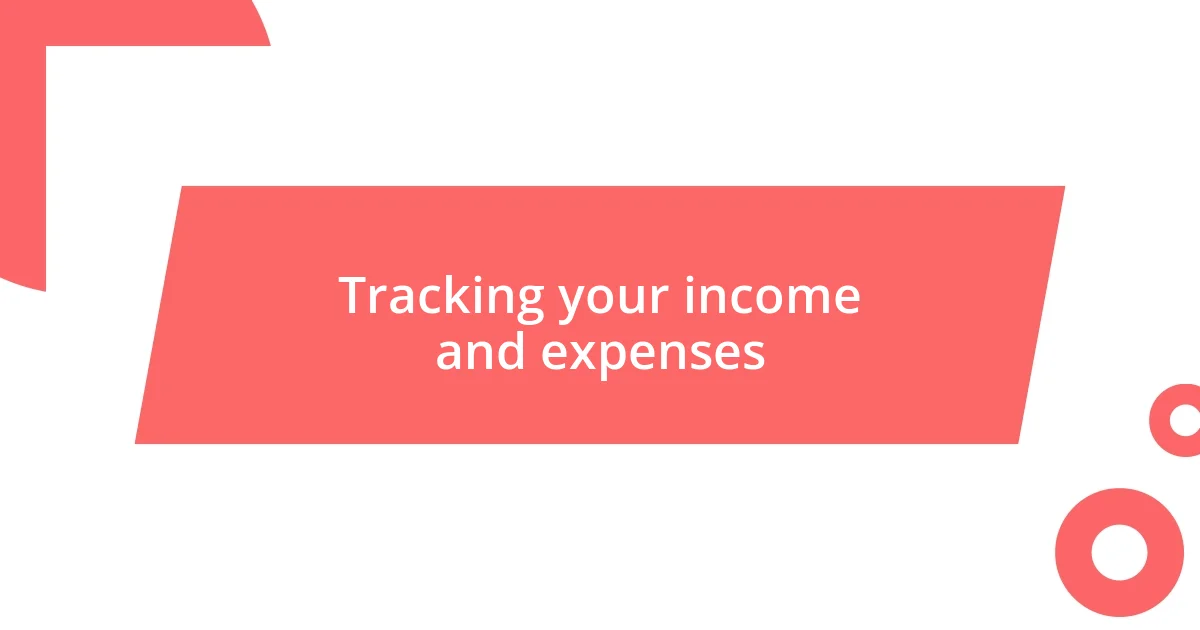
Tracking your income and expenses
Tracking your income and expenses is the backbone of effective budgeting. I’ve found that keeping a close eye on these financial flows can be quite revealing. For example, when I first started tracking my expenses through a simple spreadsheet, I was shocked to see how much I was spending on dining out. It made me realize how small, daily indulgences can wreak havoc on a budget—once the numbers were laid out clearly, it sparked a commitment to cooking at home more often.
As I refined my approach, I began using budgeting apps that sync with my bank accounts. This shift transformed my financial awareness by providing real-time updates. In one instance, I received a notification that I was nearing my monthly dining budget limit. This instant feedback not only helped me pivot towards more sustainable spending but also instilled a sense of discipline I had previously struggled to maintain. Have you ever thought about how technology could ease your budgeting struggles?
I believe that regularly reviewing your income alongside your expenses is crucial. Every month, I set aside time to analyze my spending trends and income patterns, crafting insights that help me make informed adjustments. This practice doesn’t just keep my budget on track; it also enhances my financial literacy. With each review, I become more skilled at forecasting my spending and planning for the future, and that sense of confidence is undeniably empowering.
| Method | Description |
|---|---|
| Spreadsheets | A manual method for entering income and expenses, often helpful for beginners. |
| Budgeting Apps | Automated tools that track expenses in real-time, syncing with bank accounts for immediate insights. |
| Monthly Reviews | A regular practice of assessing income and expenses to adjust budgets accordingly. |
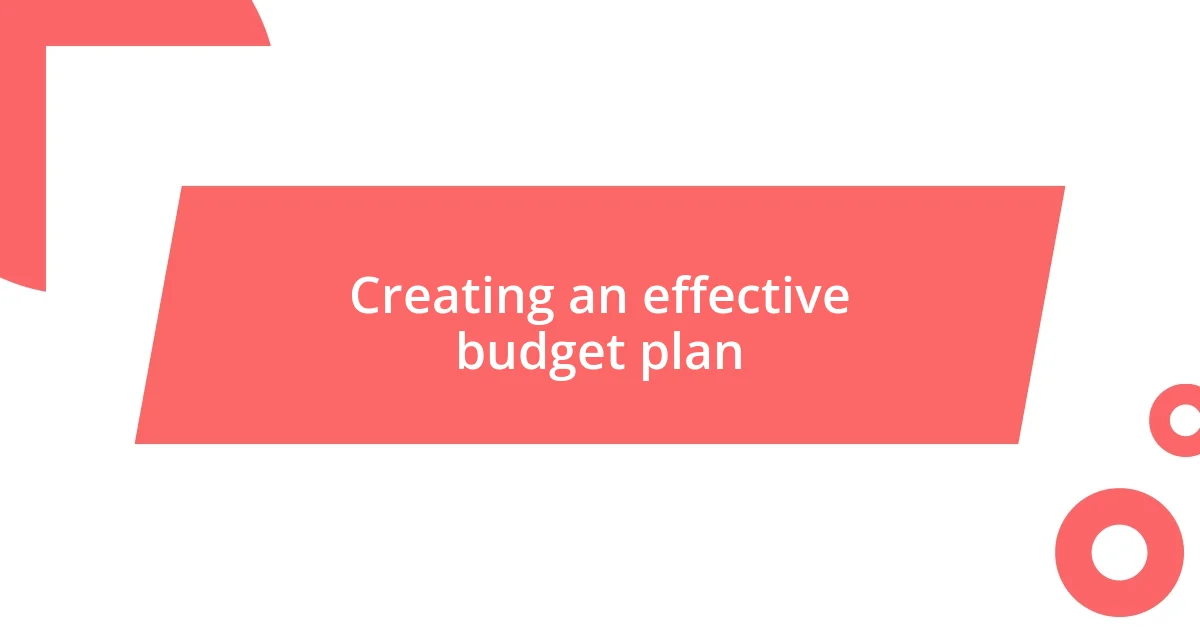
Creating an effective budget plan
Creating an effective budget plan means understanding your priorities and tailoring your strategy to fit your lifestyle. I once found myself overwhelmed by generic budgeting methods that didn’t resonate with my unique situation. It was only when I took the time to draft a personalized budget plan that I felt a true sense of control. For example, I allocated more for groceries and less for entertainment, recognizing that cooking is both my passion and a cost-saving measure.
I remember experimenting with a basic envelope system to manage my discretionary spending. Each envelope represented different categories, like dining out or hobbies. When the cash was gone, it was a visual reminder to rein it in, which brought a delightful mix of accountability and challenge to my spending. Have you ever tried a similar method? Finding something tactile really drove the lesson home for me.
Budgeting isn’t just about the numbers; it’s about the emotional journey too. Adjusting my budget to accommodate unexpected expenses, like medical bills, made me realize just how essential an emergency fund can be. I learned that an effective plan is flexible, evolving to meet my needs while providing a safety net. In turn, this adaptability fostered a sense of peace in my financial approach—something that was once quite elusive to me.
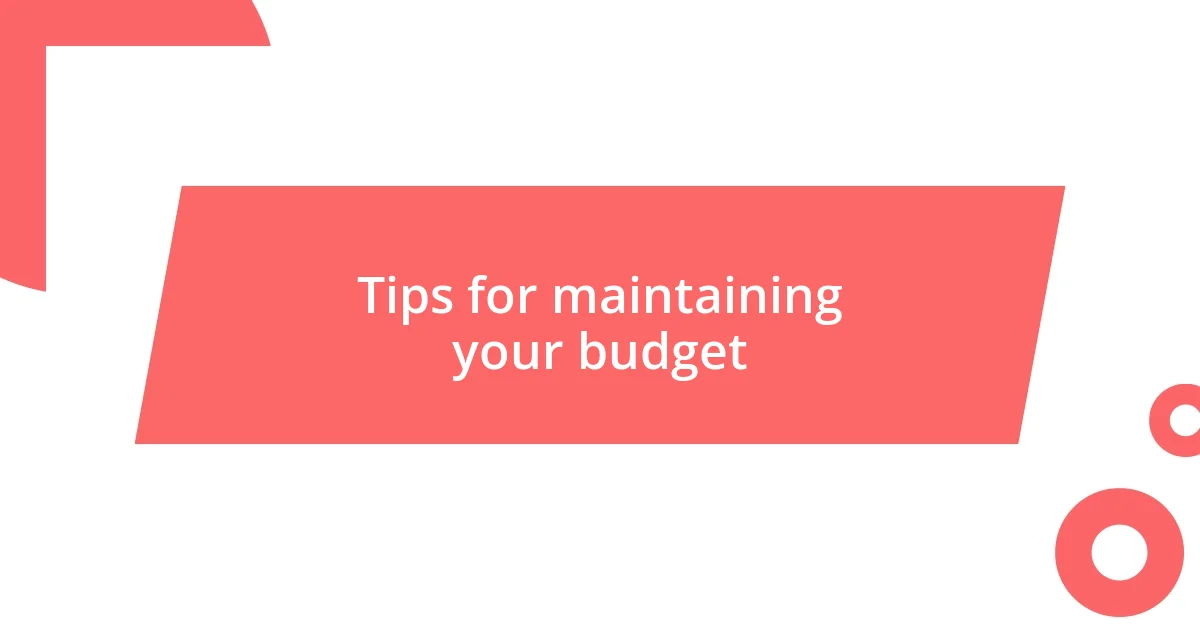
Tips for maintaining your budget
Maintaining a budget requires persistence and creativity. I’ve learned that setting up automatic transfers to my savings account at the beginning of each month takes the pressure off my spending decisions later on. It’s freeing to know I’m prioritizing my savings before anything else, almost like paying myself first. How do you prioritize your savings?
In my experience, it also helps to create a visual representation of your budget—like a colorful chart or a compelling graph. The first time I drew mine out, it turned budgeting into a fun project rather than a chore. As I watched my expenses align with my savings goals each month, I felt a mix of accomplishment and motivation that kept me engaged and committed to my financial journey. Have you thought about how visuals can simplify complex information?
I find that accountability is key. Sharing my budget goals with a trusted friend turned out to be a game changer. We check in with each other regularly, and those conversations transform budgeting from a solitary task into a shared experience. There’s something enriching about discussing our progress and challenges. It reminds me that I’m not alone in this journey, and that connection fuels my determination to stick to my budget. What about you? Have you ever asked a friend to hold you accountable?
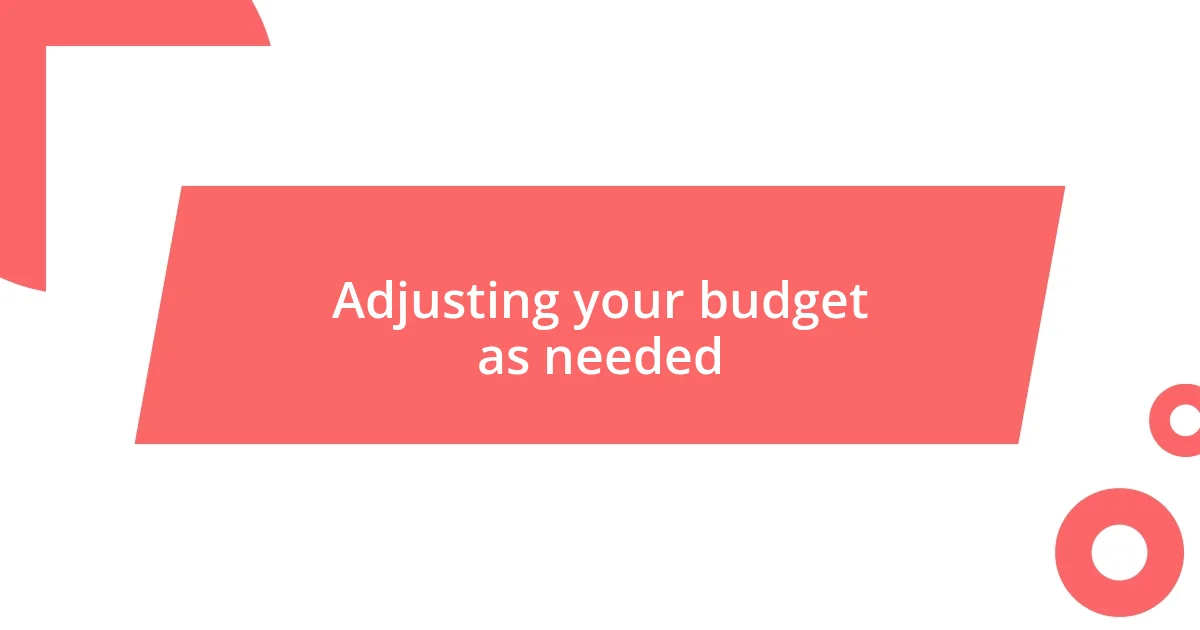
Adjusting your budget as needed
A crucial part of successful budgeting is recognizing when it’s time to make adjustments. There have been months when unexpected repairs or spontaneous events cropped up, and my original budget no longer made sense. In those instances, reallocating funds became necessary, and I actually felt a sense of empowerment in doing so—like I was taking command of my financial narrative rather than letting it control me.
When tweaking my budget, I often revisit my priorities and spending habits, asking myself probing questions. For instance, “Is that subscription really worth it, or have I just been keeping it out of habit?” This reflective process has led to surprising revelations about unnecessary expenses I can trim. I recall the day I axed a couple of streaming services; I felt like I had freed up money to invest in experiences that brought more joy, like dining with friends.
Moreover, I’ve also learned the importance of tracking my spending over time. Using an app that provides insights into my habits helped me detect patterns and adjust budgets accordingly. It’s astonishing how looking back on my spending can reveal triggers or temptations that need to be addressed to stick to my goals. Have you evaluated your spending patterns lately? You might discover hidden opportunities for adjustment that could bring improvements to your financial well-being.














